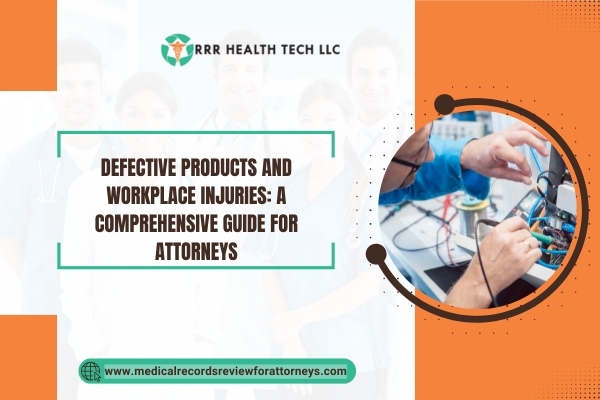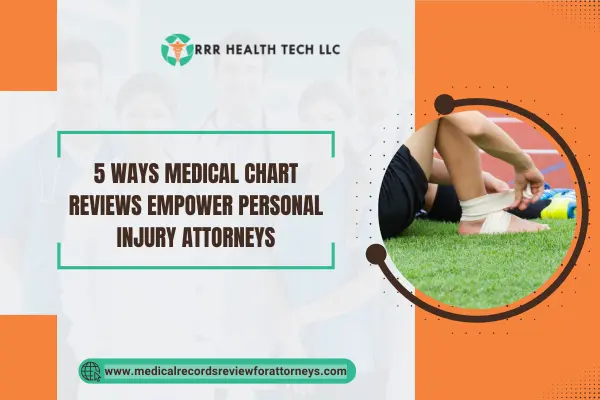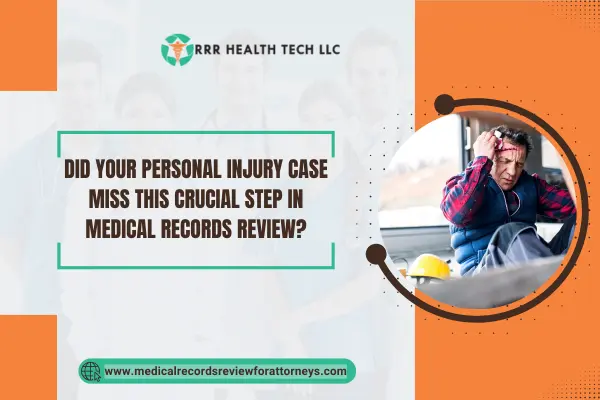
Introduction
Whenever an employee is injured in the place of work, his employer, the employee, and the economy of the country, as a whole, incurs loss. Typical causes of such injuries are defective products. For an attorney, it is important to recognize the nuances involved in the case of a defective product case, especially in the context of medical record review. This article aims to discuss defective products as one of the causes of workplace injuries, their types, available statistics, and prevalence of medical record review as an auxiliary measure in proving one’s case adequately.
What are Defective Products?
A defective product may be defined as a product which is unsafe for use due to design, manufacturing or labelling imperfections. Such products have the potential to cause harm to consumers or employees using such products in the course of work. Construction and manufacturing or even healthcare are some industries where defective products might be present.
Common Injuries Caused by Defective Products in the Workplace
Defective products can lead to a range of injuries, from minor to severe. Some of the most common injuries caused by defective products in the workplace include:
- Musculoskeletal Disorders: Defective products may result in awkward postures being adapted by employees to use such products, eventually resulting in musculoskeletal disorders like carpal tunnel syndrome, tendonitis and back injuries.
- Cuts and Lacerations: Other causes of cuts and tears include sharp edges, defective blades, or any design fault that can result in cuts that can get infected, leave scars, or even require amputations.
- Electrical Shock: Some electrical products contain defects hence can cause electric shock where there is a risk of cardiac arrest and severe injuries like burns.
- Respiratory Problems: Impaired products are capable of emitting harmful substances that lead to asthma, bronchitis, lung carcinoma, and other complications.
Statistics on Defective Products and Workplace Injuries
The Bureau of Labor Statistics (BLS) reports that in year 2020, there were 2.7 million nonfatal injuries and work-related sicknesses in the United States. Of these, 34.5 % were due to contact with objects or equipment and can be ascribed to defective products
In a 2019 research conducted by NIOSH it was found out that costs related to work related injuries and illnesses in the United States reached a hefty tw0 hundred seventy one billion dollars.
The Role of Medical Record Review in Defective Product Cases
Medical record review is a critical component of defective product cases. As an attorney, it’s essential to have a thorough understanding of your client’s medical history, including their injuries, treatment, and prognosis. Medical record review can help you:
- Identify Causation: Determine whether the defective product caused the injury or illness.
- Assess Damages: Calculate the extent of the damages, including medical expenses, lost wages, and pain and suffering.
- Build a Strong Case: Use medical records to build a strong case, including expert testimony and evidence.
How Medical Record Review Companies Can Help Attorneys
As a medical record review company, we understand the complexities of defective product cases. Our team of experts can help attorneys:
- Medical Records Review: Identify cases, diagnoses, treatments, medications within medical records given to them.
- Data Interpretation: Describe relationships, patterns, trends between the defective product and the injury/disease/death associated with it.
- Expert Witness Provision: Respective witnesses to your suit, including medical witnesses and industry witnesses.
Case Study 1: Defective Power Tool
Overview of the Case: A construction worker lost his finger while using a defective power tool.
Challenges: The defendant asserted that the worker acted carelessly and did not observe conventional safety procedures.
Solutions: Following the worker’s medical history, surgical ophthalmoscopy and rehabilitation purchase records were examined by our medical record review team. We sought opinions from other experts in the field regarding missing parts in the power tool design.
Case Study 2: Defective Respirator
Overview of the Case: A factory worker developed respiratory problems following a use of a defective respirator.
Challenges: The defendant’s position was that the capacity of the employee to work was compromised not by the job or the exposure to toxic conditions but with pre-existing conditions.
Solutions: A medical records review team was mailed to retrieve and review the lung function tests and other medical history of the worker. Exposure level of some of the toxic chemicals was also verified from occupational health professionals.
Conclusion
It is evident that defective products create hazards at the workplace exposing the employees to the risk of suffering an injury and the employer suffering financial loss. As lawyers, it is imperative to comprehend the nuances surrounding such cases in order to represent the clients effectively. Medical record review is an important step in proving the cause, proving the loss incurred and assisting in making the case. The role of medical record review in these instances puts solicitors in a relationship with anxiety because it helps them understand the ins and outs of defective product litigation. This makes it easy for the solicitors to receive fair compensation for their clients.


